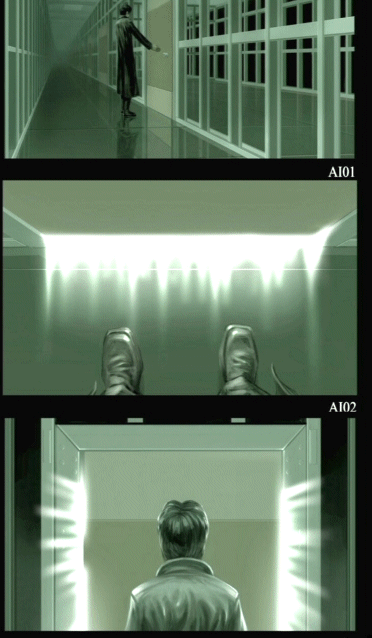
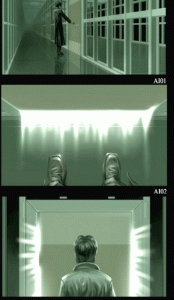 Archival interview with Steve Skroce from the official Matrix website.
Archival interview with Steve Skroce from the official Matrix website.
MATRIX: Give us a little bit of your history; how did you come to be working on THE MATRIX 2 and 3?
STEVE: Well, it’s very similar this movie that Peter Sellers did called The Party. In that, Peter Sellers was on this list of people not allowed to go to the party, but got invited by accident, that’s pretty much how I was hired – I was on the list of people not to be hired, but they got mixed up, and here I am.
MATRIX: You were one of the Storyboard Artists for the first MATRIX film, how does your experience differ from then to now?
STEVE: As far as the working relationship goes, it is pretty much the same with the Directors. The main difference is that I know these movies are going to be made; when I worked on the first film I never knew whether it was going to be green lit and produced. The environment is also different: there are a lot more people, a lot more artists. Just in terms of scale it’s about 3 or 4 times the size of the original movie. Things are much slicker around here, you get to see the guts of how a movie is made. With the first one it was pretty much just an Art Department, whereas here we have basically all the levels of the filmmaking process around us, which is cool.
In terms of scale there’s just more of everything, it has gone to a much higher level. Because the first one was such a success the budgets have gone up, and the technology has advanced from the first movie enough for more of the Directors’ crazy, impossible ideas to be done now. There are a lot more visual effects than in the first film. One of the things the Directors like is really, really precise images that are as close to what you’re going to see in the film as possible. They like the artwork very tight so that pretty much everyone who sees the artwork, whether it be Visual Effects or people doing the stunts, sees everything as close to what the Directors have envisioned as possible.
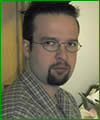 MATRIX: Have Location Scouts brought back location reference for you to work from?
MATRIX: Have Location Scouts brought back location reference for you to work from?
STEVE: Yeah, that’s cool, that is something that is different from the first movie. We’ve got all these people and resources that weren’t available before because the movie is considered a success and they can spend money on things that, before, when it was just one of the many projects in development, they didn’t have. So we have really good, really cool reference of places where they’re going to shoot, like sometimes the actual location where scenes will be shot, so the boards are actually pretty close to what you’re going to see in the films; reference material takes out some of the guess work.
MATRIX: Could you outline the process involved in creating one of your storyboards?
STEVE: The Directors usually sit down and give me an assignment. They’ll have the shots they want me to do, and sometimes they’ll have these little thumbnail, stick figure drawings of the shots they want. From that and their description, I’ll go and do tighter little sketches that have a little more structure to them for the Directors to decide if this is what they want, or if we’re getting closer to the shot they have in their mind. When a sketch is approved and it’s where they want it, I take all those sketches and produce the actual boards. Sometimes, if a sequence is very complex, like for the car chase in this film, we use toy cars and action figures, they are very much a tool, and when I’m drawing I use them as well.
MATRIX: What kind of time frame are you talking about from first discussion with Larry and Andy to illustrating the final board?
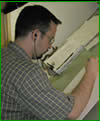 STEVE: It takes a while to draw these things so I get a handful of shots at a time, or a few beats to a sequence; I’ll go and do them then come back and get some more.
STEVE: It takes a while to draw these things so I get a handful of shots at a time, or a few beats to a sequence; I’ll go and do them then come back and get some more.
MATRIX: When did you first read the script for THE MATRIX 2?
STEVE: I got here in June [2000] and probably read it a couple of months before, in April. I’ll be here for as long as they need me.
MATRIX: How have you seen your own drawing style develop since you worked on the first film?
STEVE: I think the difference is that I’ve learned to draw a little bit more than in the first movie. Getting to work with artists like Geof Darrow and Larry and Andy [Wachowski] has helped my artistic skills, so there’s a lot more I’m able to do successfully with pen and ink than I was able to do for the first film. Everything in this movie is much bigger than the first one, so I definitely need the ability. For this film I have reference, Neo looks cool in these storyboards, rather than looking like he shops at an outmoded department store like in my storyboards from the first film – all he wears in the original drawings is a T-Shirt. In these illustrations he wears cool Neo clothes and he looks kind of like Reeves.
MATRIX: There is a team of pre-visualization people here, do you interact with them at all?
STEVE: They work from everybody’s illustrations making animated cartoons which are actually little rough moving storyboards so you can see how these things are going look in motion in the actual shot, rather than just static images. You can get an idea of the actual experience of seeing the effect or stunt, or whatever, a little bit better than you could when just looking at flat images. It is really neat seeing that stuff come to life at this early stage.
MATRIX: What other projects did you work on between finishing THE MATRIX and beginning THE MATRIX 2 and 3?
STEVE: I worked for Marvel Comics doing a comic, which I wrote and drew myself, called Wolverine. That took up a couple of months of my time, and I worked on a couple of other books before that.
MATRIX: Can you give us a blurb on Wolverine?
STEVE: Action adventure story starring Marvel’s favorite mutant The Wolverine. There’s the usual stuff – there are bad guys, they try to kill him and he kills them, and there’s a lot of stabbing and gunfire.
MATRIX: Thanks Steve.
Interview by REDPILL
November 2000

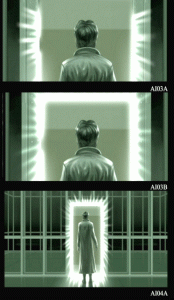
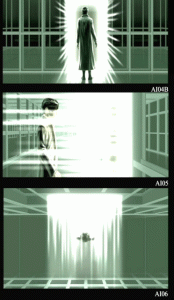
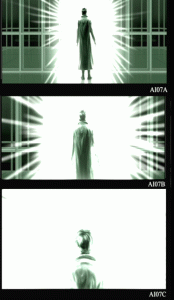
Be the first to comment